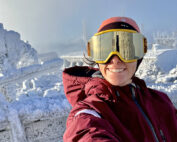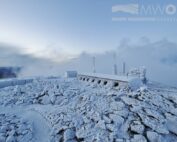Citizen Science Puts Weather Reporting in Your Hands

Ryan Knapp, Weather Observer & Meteorologist
March Newsletter: Eclipse, Big Wind, and Spring’s Wild Weather
Looking up as lenticular clouds start to form at sunset on the leeward side of Mount Washington on Feb. 25. Dear Member, Welcome to meteorological spring! This season is known for some of the wildest weather on Mount Washington. And true to form, the day before
February Newsletter: Deep Winter with Events on the Horizon
Weather Observer Karl Philippoff, left, and winter intern Tricia Hutton enjoy the sunset on January 15. Dear Member, The deep winter that defines Mount Washington has arrived. Weather averages tell the story of this season, with February's temperatures averaging at 6 °F, and snow and ice
Solar Eclipse 2024: A Celestial Wonder
Solar Eclipse 2024: A Celestial Wonder By Ryan Knapp As you might have heard through social media, the news, magazines, friends, family, etc., a solar eclipse is about to be viewable across North America. This rare and awe-inspiring phenomenon will take place on April 8, 2024,
Forecast Discussion is Key to Interpreting Complex Mountain Weather
Forecast Discussion is Key to Interpreting Complex Mountain Weather As a meteorologist, I’ve had opportunities to forecast for a wide variety of environments and audiences. From the roads of Vermont to the valleys of
Returning to Mount Washington Observatory
Returning to Mount Washington Observatory Weather Observer & Education Specialist enjoys winter conditions on Sept. 24. Hello! My name is Alex Branton and I am a new Weather Observer & Education Specialist at Mount
Septem-burrr!
Septem-burrr! 2022-09-25 20:07:59.000 - Ryan Knapp, Weather Observer/Staff Meteorologist The summit of Mount Washington has experienced freezing temperatures and rime/glaze ice three times (so far) this month. And with the recent cold snap, the


